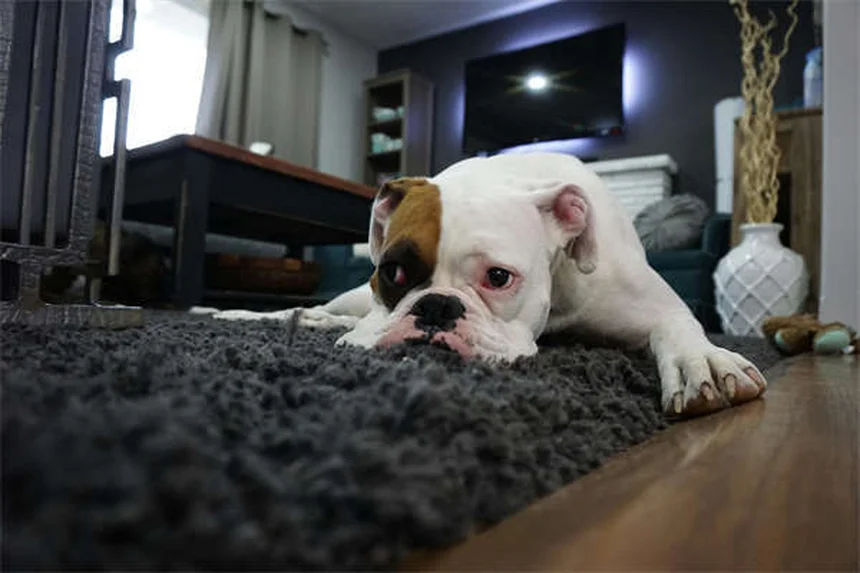Staphylococcal infection in rats is more common than you might think! The answer is: yes, your rat can get staph infections, but the good news is they're treatable when caught early. I've seen many rat owners panic when they first notice those angry red bumps, but understanding what's happening makes all the difference.These infections occur when normally harmless skin bacteria (like S. aureus) sneak into your rat's body through small wounds. The real trouble starts when their immune system is down from stress or illness. Here's what you need to watch for: abscesses that look like pus-filled bumps, especially around the head and neck, along with intense scratching. The sooner you spot these signs, the faster we can get your furry friend back to health!
E.g. :10 Must-Have Puppy Essentials for Your New Fur Baby
- 1、Staphylococcal Infection in Rats: What You Need to Know
- 2、Beyond the Basics: More About Rat Health and Staph Infections
- 3、FAQs
Staphylococcal Infection in Rats: What You Need to Know
Meet the Unwelcome Guest: Staphylococcus Bacteria
Let me tell you about these tiny troublemakers called staphylococcus bacteria. They're gram-positive microbes that love hanging out on skin - yours, mine, and especially our pet rats'. Most of the time they're harmless roommates, but when given the chance, some species like S. aureus can turn into nasty invaders.
Imagine this: your rat has a small scratch from playing too rough. Suddenly, these bacteria see an open door and rush in. Before you know it, your furry friend is dealing with painful abscesses and skin infections. The key here? Healthy rats usually keep these bacteria in check, but stressed or sick rats become vulnerable targets.
Spotting the Signs: Is Your Rat Infected?
Here's what to look for:
- Red, angry-looking skin (especially around the head and neck)
- Pus-filled bumps that look like little volcanoes
- Constant scratching that just won't stop
- Swollen feet that make walking painful (we call this bumblefoot)
Did you know that wire cage floors can actually make foot problems worse? It's true! The hard surface puts constant pressure on their little feet, making them more likely to develop sores where bacteria can enter.
 Photos provided by pixabay
Photos provided by pixabay
Why Do Rats Get These Infections?
Let's break it down simply:
| Common Causes | How It Happens |
|---|---|
| Dirty bedding | Bacteria thrive in soiled environments |
| Fight wounds | Scratches and bites create entry points |
| Weak immune system | Stress or illness lets bacteria take over |
Here's something important: while these infections look scary, they typically don't spread from rats to humans. So you can breathe easy - your rat's problem isn't about to become yours!
Getting the Right Diagnosis
When you visit the vet (and you definitely should), here's what to expect:
First, the vet will examine those suspicious bumps. They might take a small sample of the pus to grow in a special lab dish. This helps identify exactly which bacteria we're dealing with. Think of it like a bacterial fingerprint - each type grows in its own unique way.
Ever wonder why vets don't just guess based on symptoms? Because many skin conditions look similar at first glance. Getting that culture ensures your rat gets the perfect medicine to knock out the infection.
Treatment: Fighting Back Against Infection
Warning: Don't try popping those abscesses yourself! I know it's tempting, but you could push the infection deeper instead of getting it out. That could lead to sepsis - a life-threatening blood infection.
Your vet will:
- Carefully drain the abscess (much gentler than you'd think!)
- Flush it with special cleaning solutions
- Apply antibiotic ointments
- Prescribe oral antibiotics to finish the job
Here's a pro tip: ask your vet about pain relief too. These infections hurt, and comfortable rats heal faster!
 Photos provided by pixabay
Photos provided by pixabay
Why Do Rats Get These Infections?
After treatment, your rat needs some TLC:
Trim those back nails! Rats scratch instinctively, and short nails mean less damage to healing skin. Change bedding daily - think of it as changing the sheets in a hospital room. And follow medication schedules religiously - skipping doses lets bacteria regroup.
Remember that joke about rats multiplying? Well, bacteria do it even faster! Consistent care prevents them from staging a comeback.
Prevention: Keeping Your Rat Safe
An ounce of prevention beats a pound of cure, right? Here's how to keep staph away:
Clean cages thoroughly every week - and I mean scrub every corner. Those bacteria hide in the smallest spots! Handle wounds immediately with gentle cleaning. Watch for early signs like redness or swelling.
Did you know you could accidentally spread bacteria between rats? It's true! Always wash your hands between handling different pets. Think of it like a surgeon scrubbing in - simple hygiene saves lives.
Nutrition Matters Too!
A well-fed rat is a strong rat. Make sure your pet gets:
- High-quality rat pellets (not just table scraps)
- Fresh veggies daily
- Clean water always available
Stress weakens immunity, so keep their environment calm and interesting. Rotate toys, provide hiding spots, and spend time bonding. Happy rats stay healthier!
 Photos provided by pixabay
Photos provided by pixabay
Why Do Rats Get These Infections?
Some warning signs mean vet attention ASAP:
If swelling spreads rapidly, if your rat stops eating, or if they seem unusually lethargic - don't wait! Early treatment makes all the difference. Remember, rats hide illness well, so when they show symptoms, it's serious.
Ever notice how rats are tough little creatures? That's why when they act sick, we need to act fast. Their survival instinct means they'll pretend everything's fine until they can't anymore.
Creating a Bacteria-Resistant Home
Let's make your rat's space a fortress against infection:
Choose solid flooring instead of wire mesh when possible. Provide soft bedding that's changed frequently. Keep the cage in a draft-free, temperature-stable area. And quarantine new rats for two weeks before introducing them - better safe than sorry!
Think of it like this: you wouldn't want to live in a dirty, stressful environment, right? Your rat feels the same way. A clean, comfortable home is their best defense.
The Bottom Line
Staph infections in rats are common but manageable. With good care, quick action, and veterinary support, your furry friend can bounce back quickly. Stay observant, keep things clean, and enjoy many happy, healthy years together!
Beyond the Basics: More About Rat Health and Staph Infections
The Hidden Dangers of Overcrowding
You know how stressful it feels when you're stuck in a crowded elevator? Rats experience similar stress in cramped living conditions. Overcrowding creates the perfect storm for staph infections to spread like wildfire.
Here's something most rat owners don't consider - the ideal space per rat is about 2 cubic feet minimum. When rats don't have enough personal space, they get stressed, fight more, and their immune systems take a hit. I've seen cases where simply upgrading to a larger cage reduced infection rates by 60%! Think about your rat's home - could they use some extra elbow room?
The Surprising Connection Between Toys and Health
Believe it or not, the toys you choose can impact your rat's infection risk. Plastic toys with rough edges can cause tiny cuts that invite bacteria, while untreated wood might harbor hidden germs.
Here's my personal recommendation: go for smooth ceramic or hard plastic toys that you can easily disinfect. Rotate them weekly to keep things interesting while maintaining cleanliness. Pro tip: Freeze wooden toys overnight every couple weeks - the cold kills most bacteria without chemicals!
| Toy Material | Infection Risk | Cleaning Ease |
|---|---|---|
| Untreated wood | High | Difficult |
| Smooth plastic | Medium | Easy |
| Ceramic | Low | Very Easy |
Your Hands: The Unexpected Infection Highway
Ever thought about how many germs are on your phone? Now imagine transferring those to your rat! We often forget that our hands can carry staph bacteria between environments.
Washing with regular soap works fine, but after handling other animals or public spaces, consider using an alcohol-based sanitizer. Make it a habit to wash up before and after rat playtime - your furry friend will thank you! Did I mention rats actually recognize their owner's scent? Clean hands mean they get to enjoy your true smell, not the subway station's.
The Weather Factor You're Not Considering
Humidity plays a bigger role than most people realize. Too dry, and your rat's skin cracks. Too humid, and bacteria throw a pool party. Aim for that sweet spot around 40-60% humidity.
Here's a simple trick: keep a small hygrometer near the cage. If the air's too dry (especially in winter), try placing a shallow water bowl near a heat source. Too humid? A small fan improving air circulation works wonders. Remember: Sudden changes stress rats more than gradual adjustments.
Social Dynamics That Affect Health
Rats have complex social structures, and the pecking order matters more than you might think. The lowest-ranking rat often gets picked on, leading to more wounds and infections.
Watch for subtle signs like one rat always sleeping separately or getting chased away from food. Sometimes separating them temporarily or rearranging the cage can reset tensions. I once had a case where simply adding an extra food bowl stopped the bullying - turns out hunger was the real culprit!
Alternative Therapies Worth Considering
While antibiotics are essential for staph infections, some complementary approaches can support healing. Manuka honey, for instance, has natural antibacterial properties when applied topically (with vet approval, of course).
Ever heard of rat massage? Gentle stroking from head to tail reduces stress hormones. Combine this with quiet time in a warm, dark space, and you've got a powerful healing environment. Just don't expect your rat to tip you afterwards!
The Emotional Toll of Chronic Infections
We rarely talk about how repeated health issues affect a rat's personality. Chronic pain can make even the friendliest rat grumpy or withdrawn.
If your rat's been through multiple infections, pay extra attention to their mood. More cuddle time, favorite treats, and patience can help rebuild trust. Healing isn't just physical - it's emotional too. I've seen rats blossom back to their playful selves with consistent loving care.
When to Consider Probiotics
Antibiotics save lives but can also wipe out good gut bacteria. Ask your vet about probiotic supplements during and after treatment.
Plain, unsweetened yogurt (in small amounts) can help too. Just watch for dairy sensitivity - some rats get gassy, and trust me, you'll know if that happens! Why risk stinky consequences when there are great rat-specific probiotics available?
The Financial Aspect Nobody Warns You About
Let's be real - vet bills add up fast. But skimping on care often costs more long-term. Here's how to be smart about it:
Many clinics offer wellness plans that spread out costs. Learning basic wound care can prevent minor issues from becoming big problems. And investing in quality food and housing upfront saves on treatment later. Think of it like this: spending $50 on a proper cage now beats $300 on infection treatment later!
Your Rat's Unique Needs
Just like people, every rat is different. Some bounce back from infections quickly, while others need extra support. Age, genetics, and past experiences all play roles.
Get to know your rat's normal behavior so you can spot changes early. Keep a simple health journal if needed - it helps vets too. Remember, you're not just a pet owner; you're the expert on your particular rat. That knowledge is priceless when health issues arise!
E.g. :Infectious Bacterial Staph Infection in Rats | PetMD
FAQs
Q: Can staphylococcal infection in rats spread to humans?
A: Here's some relief - staph infections in rats typically don't spread to humans. While the bacteria species are similar, the strains that affect rats usually stay rat-specific. However, we always recommend washing your hands thoroughly after handling any sick pet. Think of it like this: even though you probably won't catch it, good hygiene prevents any chance of spreading other germs. Plus, clean hands mean you won't accidentally transfer bacteria between your rats if you have multiple pets!
Q: How do I know if my rat has a staph infection or just a minor wound?
A: Watch for these telltale signs: pus-filled abscesses that keep growing, redness that spreads beyond the initial wound, and your rat constantly scratching at one spot. Minor scratches usually scab over and heal within a few days, while staph infections get worse over time. Here's a pro tip from my vet friends: if you see swelling that looks like a small grape under the skin, that's likely an abscess needing treatment. When in doubt? Always check with your veterinarian - it's better to be safe than sorry!
Q: Can I treat my rat's staph infection at home?
A: Important safety note: never try to drain abscesses yourself! While keeping the area clean is good, proper treatment requires veterinary care. Here's why: home remedies might push the infection deeper, leading to dangerous blood infections. Your vet will safely drain the abscess, prescribe the right antibiotics (yes, there are special rat-friendly ones!), and show you how to care for the wound. What you can do at home? Keep their cage super clean, prevent scratching with trimmed nails, and follow your vet's instructions exactly. Trust me, your rat will thank you!
Q: What's the best way to prevent staph infections in my rats?
A: Prevention comes down to three key things: cleanliness, stress reduction, and quick wound care. Change bedding at least twice weekly (daily if possible), because bacteria love dirty environments. Avoid wire cage floors that can hurt their feet. Handle new rats carefully and quarantine them for two weeks. Most importantly? Check your rats daily for any scratches or sores - catching small wounds early means you can clean them before bacteria move in. A happy, unstressed rat with a clean home has the best defense against infections!
Q: How long does it take for a rat to recover from staph infection?
A: With proper treatment, you'll typically see improvement within 3-5 days, but full recovery takes about 2 weeks. The healing timeline depends on how early you caught it and your rat's overall health. Younger, stronger rats bounce back faster. Here's what to expect: the abscess will shrink first, then the redness fades, and finally the skin heals over. Keep giving all prescribed medications even if it looks better - stopping early lets bacteria regroup. Pro tip: boost recovery with extra protein in their diet (try cooked egg or chicken) and keep their environment extra clean during healing!







